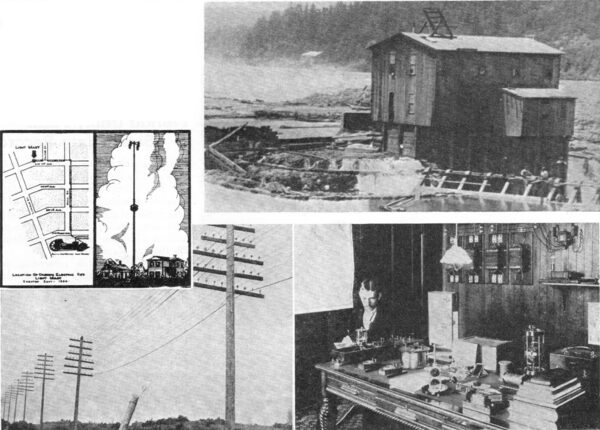[Trade Journal]
Publication: Electrical World
New York, NY, United States
p. 1929-1130, col. 1-3
Marks Opening of Line
to Transmit Electricity
Portland General Electric celebrates fiftieth anniversary of first successful transmission of power over long distances — Griffith company's predecessor made history on June 3, 1889~
Fifty years ago the Willamette Falls Electric Co., out of which organization the Portland General Electric Co. was formed, made history, Franklin T. Griffith, president, pointed out in celebrating the fiftieth anniversary of long-distance transmission of hydro-electric energy.
Mr. Griffith said that on June 3, 1889, the company transmitted electricity from Oregon City to Portland, a distance of 14 miles, and began in this city a public service that has never lapsed. As far as records go, it is believed that this was the first successful long-distance transmission of electricity for commercial purposes in the United States.
Sponsors Celebration
Portland General Electric marked the occasion by sponsoring a program at Neighbors of Woodcraft Hall in Portland on June 2, attended by representatives in the utility and electrical industry, a few of the men who worked in the original Oregon City generating plant and on the original transmission line, and the public.
| |||
| First Line — Portland General Electric Celebrated This Month the Fiftieth Anniversary of Long-Distance Transmission of Hydro-Electric Energy From Oregon City to Portland. Top Left—An Idea for Street Lighting That Failed. Lower Left—First Long-Distance Line Built by Willamette Falls Electric. Right—W. C. Cheney, First Superintendent, in His Electrical Laboratory. |
O. B. Coldwell, vice-president in charge of operations, delivered an illustrated lecture describing the early technical progress of the electrical industry in the Northwest.
Newspapers in the area gave especial attention to the celebration, with the Oregon Journal publishing a special twelve-page "Power Progress" section.
Mr. Griffith said that his company looks ahead to another 50-year period of progress in the field of public service. He declared that the company had ceased to build new hydro-electric generating plants "because the government has undertaken the great navigation and power development at Bonneville and the reclamation and power development at Grand Coulee."
"But we have," he said, "while Bonneville was being built, steadily improved our distribution facilities, and we enter this new epoch tendering these improved, far-flung facilities and our half-century of experience to help in making the plant at Bonneville another milestone in the progress of electric public service."
Charles F. Scott, professor emeritus of the School of Electrical Engineering at Yale University, wrote Mr. Coldwell of the pioneering of the Willamette Falls Electric Co. that the plant "was the first breaking away from lower voltages to the very high value of 4,000 volts. So far as I have been able to learn your plant, in the kilowatts transmitted, in the voltage used and in the distance of transmission, was the outstanding transmission of its day."
The celebration recalled the early association of H. M. Byllesby with Portland General Electric, as its early first vice-president, and the work of Sidney Z. Mitchell with the several, electric utilities in the Northwest when he was in charge of affairs of General Electric in the area prior to the formation of Electric Bond & Share.
Many of the old timers were present during the celebration and they recalled experiences of W. C. Cheney, who was the first superintendent of the Willamette Falls Electric Co., and former technical adviser for the Westinghouse Electric & Manufacturing Co.
Pictures of early ideas in street lighting were shown during the celebration. In 1884 the City Council of Portland rejected the idea of poles 150 ft. high with four to six lights intended to illuminate a distance of four to six blocks.

